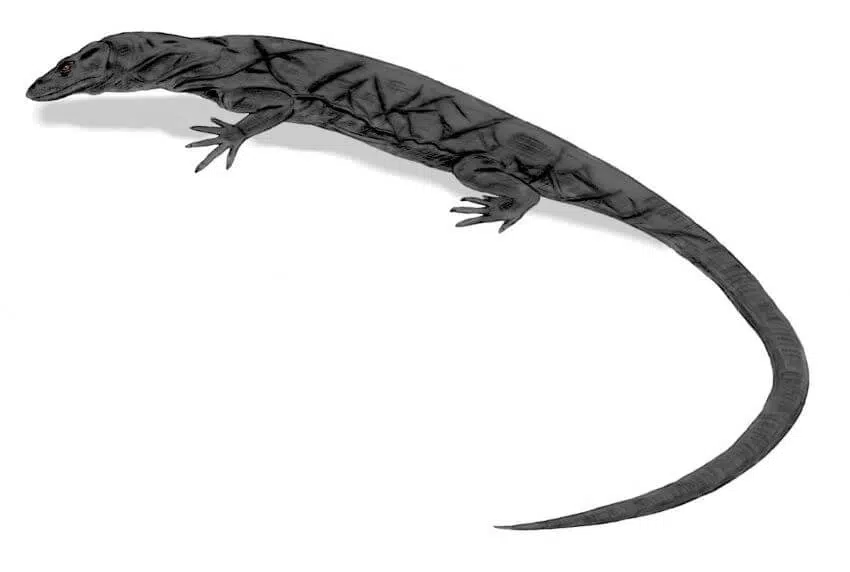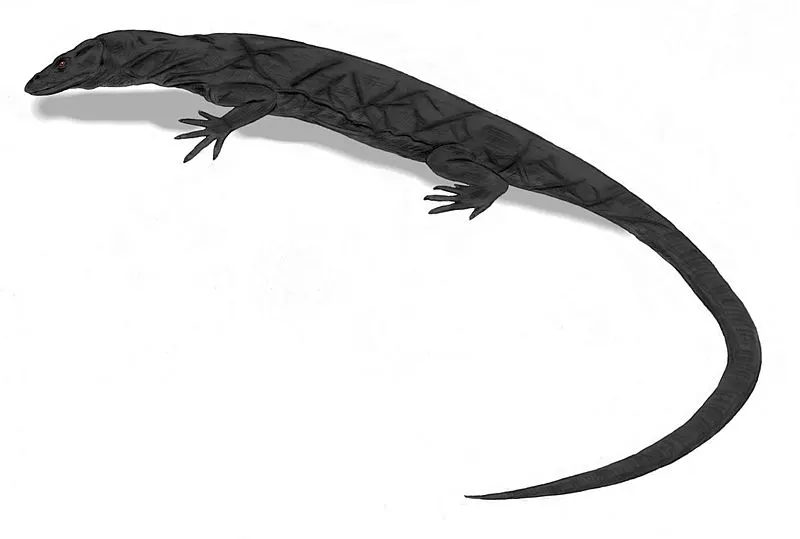Panay Monitor Lizard (Varanus mabitang) is one of the most threatened lizards in the world, and Panay’s are decreasing due to various reasons. It is important to know why the lizard is endangered in order to understand how it can be helped.
- Status: Endangered
- Known as: Panay Monitor Lizard, Mabitang
- Estimated numbers left in the wild: Defined as a separate species in 2001, there are no reliable numbers in the wild. Only 12 of these lizards have been captured. However, the population of the Panay monitor lizard appears to be falling.
The lizard species is an indicator for the future development of other species in Panay because it influences their habitat and prey population.
These monitor species of lizards are endangered because Panay holds a high human population.
As humans cut down the forests, These lizards lose habitat and prey that they need to survive. The lizards also become another casualty when there is illegal dragon-meat poaching in Panay along with other species such as pythons, cobras, and deer.

Panay is not the only island in Panay to experience illegal wildlife trade, but if the endemic lizards are eliminated then Panay’s biodiversity will suffer greatly.
It is also important that the lizards be saved because they contain various biochemical substances that can help with medicine for humans, such as antimicrobial peptides which can prevent disease and increase survival rates.
Description
The Panay endemic species of monitor lizard is a species of gecko that inhabits the Panay in the Philippines.
The species appears to be known for being one of the only lizards with skin patterns that change as they age, making them a rare lizard and which is why many people believe they have life spans longer than other types of monitors.
Unfortunately, this lizard is currently endangered due to habitat destruction and unsustainable harvesting for food or pet trade.
The Panay lizard lives a life in the treetops and is considered by some to exist solely on fruit found there.
However, there is also reason to believe that this monitor will also take bird eggs when available and perhaps insects. Its preferred habitat is in well-established trees in the lowlands rainforest (mature trees will most likely produce fruit) on Panay Island.
Not very much is known, at this point, about the breeding habits of the monitor lizard. Because the species was only described in 2001, little research has been done on even the most basic facts of this lizard’s life.
Panay monitor lizard Anatomy and Appearance

This lizard is also known as the Panay Monitors, Panay Giant Lizard, or Panay Island Monitor. These lizards are closely related to the Komodo Dragon and Varanus. Along with their close relationship to the Komodo Dragons, these lizards are found in Indonesia. Indonesia is home to the largest variety of lizards.
But these lizards are not dangerous! In fact, they are timid and avoid humans as much as possible. They also rarely bite even when provoked.
They can grow to be about 3 feet long from snout to the tip of the tail.
These lizards are also known to have a crest of spiky scales running down their back, but this is more visible in juveniles than adults. One more physical feature that makes Panay lizard were unique for the presence of two black stripes on either side of the neck and head region.
The lizard is much more slender than is usually the case with lizards in this family. The background coloration of the lizard is dark grey-brown with black markings. The head is elongated, and the tail is longer than the body and head combined.
See Related: Fascinating Facts About Conservation
Location
The Panay monitor occurs and is found exclusively on Panay Island in the Philippines. It needs mature rainforest and primary forest ecosystems with sufficient fruiting trees to survive.
See Related: Philippine Eagle
Panay Monitor Lizard Habitat
The Panay endemic lizard is a critically endangered species inhabiting remnant forests of the Island in Panay. The lizard species is the largest lizard in the country and is also one of the most endangered. Its habitat is being threatened by deforestation and development.
Panay Monitor Lizard Diet and Nutrition
This lizard species are carnivorous and eat mostly insects, but will also eat small lizards, snakes, and birds. Panay endemic lizards have sharp teeth that are good for catching their prey. They have a forked tongue that helps them smell their food.
They also have a long tail that helps them balance while they’re running.
They eat their food whole and don’t chew it. The lizards’ habitats include rain forests, swamps, Alang-Alang grasslands, and mangroves. Panay lizards lay eggs in abandoned animal burrows or hollow logs. Their predators include humans and other larger lizards.
Panay Monitor Lizard Mating Habits
These lizards are usually monogamous, and they can have up to three clutches of eggs per year. Panay lizards are oviparous, meaning that the eggs are hatched outside of the mother’s body.
Their embryos develop in a leathery eggshell and hatch after being incubated for two to three months. They are cannibalistic, and so the eggs help to reduce competition for food. These species of lizard can live for up to 10 years in the wild.
Conservation Status
Threats
Several threats are confronting the Panay lizard. One of the most serious is habitat destruction as the island is logged for its rare trees. Agricultural use also restricts the monitor’s range as human populations expand.
These lizards are unable to survive in disturbed forests where fruit trees are absent or infrequent.
In addition to habitat loss, the Panay endemic lizard is also hunted by the island’s indigenous population for food fr the species is sadly a favoured hunting target.
See Related: Endangered Species in Florida
Conservation efforts
This reptile is endangered mainly because they are hunted for their meat and skin, which is used to make handbags and fashion accessories like shoes, purses, and belts.
Their skin has an unusual quality when it comes to its dye extraction abilities when compared to other lizard species; it holds on to color much better than other monitors, making it more valuable for leather products.
Panay lizards have been hunted for both meat and skin, according to documented shows.
Because the endemic lizard is now on the CITES list, this animal cannot be legally exported without a permit. Several NGOs are working with the Philippine government to preserve forest areas for the monitors.
The study of the lizard is ongoing to provide more information that will contribute to its survival. Programs to educate villagers about the value of this rare lizard where only twelve animals are captured and are designed to prevent them from being taken as food.
See Related: Environmental Organizations in India
Organizations
Do you know of or are you a part of an organization that works to conserve the Panay Monitor Lizard?
Organizations and international varanid interest groups have ongoing conservation efforts for this species. Then please contact us to have it featured on Our Endangered World.
Final Thoughts
Panay Monitor Lizards are a critically endangered native species located on the Island of Panay.
They have been hunted for both meat and skin due to their unique leather qualities which make them valuable as fashion accessories like shoes, purses, and belts.
The lizard is on the CITES list meaning that they cannot be exported without a permit from the government of the Philippines.
Several NGOs work with Filipino officials to preserve forest areas where the lizards live so there will always be enough food sources available for this rare lizard’s survival.
FAQ
Why are Panay monitor lizards endangered?
Their population is declining because of greatly impacted habitat loss due to destruction and deforestation, hunting for food or capture as pets, competition with other species for resources, and the introduction of nonnative predators.
These species were also hunted to become goods for their meat and skin, especially for illegal national and international trade.
How does the Panay monitor lizard eat their prey?
To catch prey, these lizards will often use a short burst of speed to lunge and grab them. Their long tongue is very sticky which allows it to snatch insects from leaves as they fly past.
And if his quarry is too big, this reptile will pursue them on its massive clawed feet until he can pin the animal down with his strong jaws and forelimbs (or paws).
What predators do Panay monitor lizards have?
They have many predators, including small mammals such as deer, wild pigs, cats, and dogs. They are also eaten by larger lizards, snakes, and birds of prey.
What predators do Panay monitor lizards have?
These lizards are extremely tough to hunt. They have well-developed claws and spikes on their head, legs and tail.
These adaptations make the lizard difficult to eat alive which is why predators avoid them. Panay lizards also have an excellent sense of smell which further helps deter predators by showing when there is danger nearby.
Other Species Profiles
Related Resources
